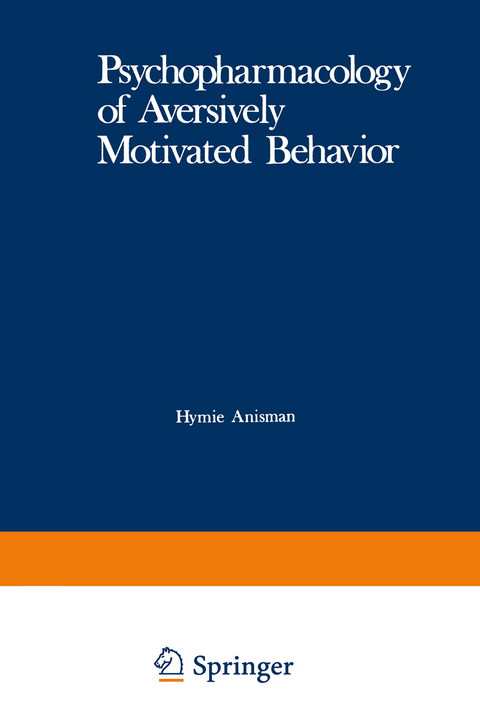
Psychopharmacology of Aversively Motivated Behavior
Springer-Verlag New York Inc.
978-1-4684-2396-9 (ISBN)
1 Aversively Motivated Behavior as a Tool in Psychopharmacologic Analysis.- I. Introduction.- II. Theoretical Models.- III. Components of Avoidance Behavior—Implications for Psychopharmacology.- IV. Strategies for the Assessment of Treatment Effects.- V. General Summary.- References.- 2 Behavioral Genetics and Animal Learning.- I. Introduction.- II. Basic Concepts and Methods.- III. Major Research Questions.- IV. Mendelian Inheritance, Pleiotropy, and Relations between Characters.- References.- 3 Neurochemical Changes Elicited by Stress: Behavioral Correlates.- I. Introduction.- II. Effects of Acute Stress on Levels and Turnover of NE, DA, and 5-HT.- III. Stress-Induced Increases in Amine Levels.- IV. Neurochemical Change and Coping Style.- V. Hormonal Changes after Stress.- VI. Genetic Factors.- VII. Stress-Induced Neurochemical Changes: Implications for Avoidance Behavior.- VIII. Implications for Human Behavior.- IX. Overview.- References.- 4 Cholinergic Mechanisms and Aversively Motivated Behaviors.- I. Introduction.- II. Selected Neurochemical Aspects of Cholinergic Drug Action.- III. Behavioral Effects of Muscarinic Agonists and Antagonists.- IV. Sites of Drug Action.- V. Nicotinic Stimulation and Blockade.- VI. General Conclusions.- References.- 5 Monoamines and Aversively Motivated Behaviors.- I. Introduction.- II. Neuropharmacology of the Monoamines.- III. Some Aspects of the Neuropharmacology of the Monamines.- IV. Catecholaminergic Mechanisms and Nonassociative Behavioral Change.- V. Catecholaminergic Mechanisms and Aversively Motivated Behaviors.- VI. Serotonergic Mechanisms and Aversively Motivated Behaviors.- VII. Conclusions.- References.- 6 Hallucinogens.- I. Introduction.- II. The General Pharmacology of Hallucinogens.- III. Effects of Hallucinogens onAnimal Behavior.- IV. Current Models and Hypotheses for the Effects of Hallucinogens.- V. Relevance to Human Effects.- VI. Conclusion.- References.- 7 Effects of Neuroleptics, Ethanol, Hypnotic-Sedatives, Tranquilizers, Narcotics, and Minor Stimulants in Aversive Paradigms.- I. Introduction.- II. Neuroleptics (Major Tranquilizers).- III. Ethanol, Hypnotic-Sedatives, and Minor Tranquilizers.- IV. Narcotic Agonists and Antagonists.- V. Miscellaneous Stimulants.- VI. Conclusions.- References.- 8 Stimulus Attributes of Drugs.- I. Drugs as Unconditioned Punishing Stimuli.- II. Drugs as Unconditioned Reinforcing Stimuli.- III. Drugs as Conditioned Stimuli.- IV. Summary.- References.- 9 A Comparative Neurochemical, Pharmacological, and Functional Analysis of Aversively Motivated Behaviors: Caveats and General Considerations.- I. Theoretical Frameworks for Aversively Motivated Behaviors.- II. Role of Neurochemical Activity in Aversive Situations.- III. Comparative Analysis of Selected Drug-Induced Syndromes.- IV. Relevance of Research on Infrahuman Subjects to Human Psychopharmacology.- V. Conclusions.- References.- Author Index.
| Zusatzinfo | XII, 564 p. |
|---|---|
| Verlagsort | New York, NY |
| Sprache | englisch |
| Maße | 152 x 229 mm |
| Themenwelt | Schulbuch / Wörterbuch |
| Medizin / Pharmazie ► Medizinische Fachgebiete ► Pharmakologie / Pharmakotherapie | |
| Medizin / Pharmazie ► Medizinische Fachgebiete ► Psychiatrie / Psychotherapie | |
| Medizin / Pharmazie ► Medizinische Fachgebiete ► Schmerztherapie | |
| Medizin / Pharmazie ► Pharmazie | |
| Naturwissenschaften | |
| Sozialwissenschaften | |
| ISBN-10 | 1-4684-2396-7 / 1468423967 |
| ISBN-13 | 978-1-4684-2396-9 / 9781468423969 |
| Zustand | Neuware |
| Haben Sie eine Frage zum Produkt? |
aus dem Bereich


